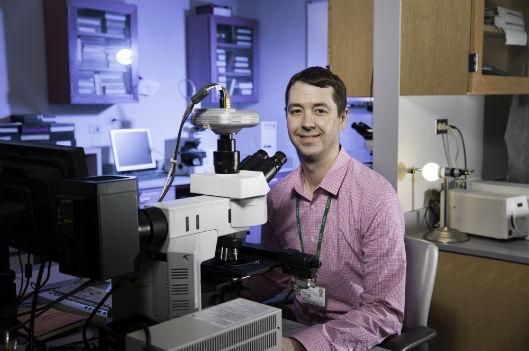Working across disciplines to find medical breakthroughs
By Mark Donahue
Collaborations are critical to biomedical research. It’s through a spirit of discussion and passionate focus that researchers sustain themselves in work that can take decades, through the ups and downs of sponsored funding, in the lab and sometimes far afield.
Collaborative studies are on the rise in general, with partnerships at Rush alone emerging around microbiology and immunology, Alzheimer’s and HIV, and work on bone and cartilage, said Tom Wilson, assistant vice president of research affairs. And this cross-disciplinary work is drawing more attention — and support — from government and private funding agencies.
“Not too many years ago, most research faculty would kind of be in a silo,” said Wilson. “And they’re doing what they do isolated in their laboratory, and they were getting funding for that research. But now sponsors’ expectations have changed, and they want to see integrated, collaborative research projects.”
A breakthrough in multiple sclerosis
The medication Ampyra — also known by its generic name dalfampridine — was born out of a collaboration among Rush clinical and basic science researchers that started more than 30 years ago.
Ampyra is used to treat multiple sclerosis (MS), an insidious disease that affects more than 2 million people worldwide. In MS, the body’s immune system mistakenly attacks myelin in the brain and spinal cord without an identifiable cause or cure. For many sufferers, symptoms such as impaired eyesight, speech and muscle function become a fact of daily life.
Ampyra is a potassium channel blocker, which enhances signaling in nerves damaged by MS, allowing patients to live more normal lives. Licensed for use in 2010, Ampyra remains the only FDA-approved therapy recognized to improve walking in MS patients.
The initial spark that led to the discovery of Ampyra dates back to the 1960s, when Floyd Davis, MD, then a neurologist in training and later a physician at Rush, observed that many multiple sclerosis patients functioned better when their body temperature was slightly lowered.
That raised the possibility that MS-damaged nerve fibers do not permanently lose the ability to transmit signals, as many before had thought.
In 1978, Davis teamed up with another Rush clinical researcher, Dusan Stefoski, MD, and they concentrated on finding a compound that could mimic some of the effects of lower body temperature. Their research led them to the potassium channel blocker 4-aminopyridine, 4-AP or dalfampridine.
Two years later, the team led by Davis published a paper on the scientific foundations of their work, and they began clinical trials in 1983. The results were immediate: Taken intravenously, 4-AP produced transient improvements in MS patients’ motor and eyesight functions.
In 1990, Rush initially licensed the proprietary know-how developed by Davis and Stefoski to a pharmaceutical company. When the company did not actively develop the drug, Rush looked for a new commercial partner. In 2003, the hospital signed a new license agreement with Acorda Therapeutics, which successfully completed the clinical development of what ultimately became Ampyra.
The FDA approved Ampyra in 2010 as an extended release tablet form, followed by regulatory approvals in the European Union and Australia. From its launch until mid-2014, Rush (and its inventors) received a running royalty on sales of Ampyra.
Rush sold its royalty rights to a private equity fund in August 2014 for about $42 million, and it has used large portions of the proceeds to fund other research.
Today the Rush Multiple Sclerosis Center is continuing its work, studying whether Ampyra can help nerves restore the myelin coating stripped away by MS and if long-term use of the drug could gradually improve muscle function, much like athletic training.
Critical conversations
Bob Eisenberg, chairman emeritus of the Department of Molecular Biophysics and Physiology, has been at Rush since 1976 and recalls the excitement around the Ampyra team’s initial breakthrough.
One of the department’s then-researchers, Charles Schauf, PhD, offered some early thoughts to Davis and Stefoski on the science behind ion channel blockade.
For Eisenberg, it’s a perfect example of how conversations that happen across disciplines are critical to research — in this case, the contribution of basic science to addressing foundational questions.
“There are things going on like that at the early stage right now,” Eisenberg said. “We don’t know which one of them is going to work. We don’t know where the interaction with the clinician may be helpful, here or somewhere else. It’s a community effort.”

